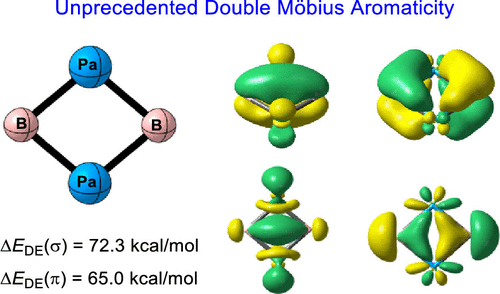JACS: Application of valence bond theory to planar quaternary bis-boron actinides with Double Möbius Aromaticity
Published Time: 2024-08-02 10:05:30
Editor's note: This research highlight showcases the application of block-localized wavefunction method with the XMVB@XACS software package by Xuhui Lin et al. at Central South University. This paper reports a quasi-square quaternary actinide compound with double Möbius aromaticity, namely Pa2B2 (diboron protactinium), which not only enriches the concept of Möbius aromaticity and opens up a new avenue in the study of actinide compounds, but also demonstrates that valence bonding theory is a powerful tool for studying and understanding the nature of chemical bonding.

The Möbius rule predicts that a planar four-membered metallacycle can be aromatic with four delocalized π electrons, but such a simple ring has escaped recognition since it usually favors Hückel antiaromaticity. In this paper, the Kohn-Sham molecular orbitals of this diboron protactinium molecule were first analyzed by applying natural bond orbitals and AdNDP analysis, revealing that the molecule has four delocalized σ electrons in addition to four delocalized π electrons, and that both the σ and π electrons satisfy the 4n Möbius rule.

The nuclear independent chemical shift (NICS) and related ring current criteria are not applicable to evaluate the aromaticity of small rings and molecules with heavy metals. Therefore, in order to further substantiate the double Möbius aromaticity of this molecule, this article seeks a better understanding of the aromaticity of this novel molecule from an energetic point of view through block-localized wavefunction (BLW). The BLW method was proposed by Professor Yirong Mo from the University of North Carolina at Greensboro in the United States, and is the simplest variant of the valence bond wave function. In this article, the energies of the system after separately localizing the σ and π Pa-B valence orbitals are performed with XMVB@XACS.
Two linear structures of the molecule were also calculated and compared with the cyclic structure to verify the aromaticity. The delocalization energies for σ and π electrons are respectively 65.0 and 72.3 kcal/mol, and the extra cyclic resonance energy (ECRE) is 45 kcal/mol. The large and positive ECRE strongly confirms the presence of the unprecedented bimobius aromaticity in Pa2B2.
This paper not only enriches the concept of Möbius aromaticity by investigating the aromaticity of diboron protactinium molecules, opening a new avenue for the study of actinide compounds, but also demonstrates that valence bonding theory is a powerful tool for studying and understanding the nature of chemical bonding.
Besides the article presented in this research highlight, in 2023, external research group conducted a series of theoretical studies on chemical bonding and aromaticity, including:
Huaiyu Zhang et al. at Hebei Normal university employed the BLW in the study of captodative effect in diboron molecule: CaptodativeEffect Facilitates the Excitation in Diboron Molecule (CAAC)2B2(SH)2 (Chem. Eur. J. 2023, 29, e202203817)
Shearer et al. at Trinity University study conducted a study on the C-C bond in high valent organocopper compounds: Bondingand the role of electrostatics in driving C–C bond formation in high valentorganocopper compounds (Chem. Commun. 2023, 59, 98-101)
We
will continue to update the research highlights on these applications of XMVB@XACS
in the future.
Paper:
Planar Four-MemberedDiboron Actinide Compound with Double Möbius Aromaticity
Xuhui Lin,* Wei Wu,* and Yirong Mo*
XACS Research Highlights
XACS Research Highlights are posts about examples of research carried out using the XACS platform. We welcome the users to submit their blog posts to us at xacs@xmu.edu.cn or directly to one of the PIs and we will highlight your research on the official XACS channels and social accounts. We reserve the right to small editorial changes for clarity and corrections.